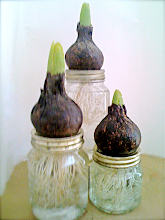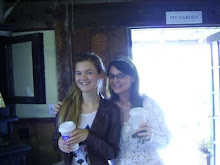Tuesday
Culling Sustenence For Less
Interesting and unusual ways to gather sustenance
George Bernard Shaw pointed out
“There is no love sincerer than the love of food”
and I heartily agree! As a confirmed Foodie,
I find a type of romance in raw ingredients.
Like Michaelangelo saw his masterpiece David
inside a block of marble,
I see berries and envision jams, juices, cobblers and pies.
Nutty whole wheat flour, water, yeast and
a bit of sugar meld to become crusty loaves of homemade bread,
the mints, verbena and lemon geraniums
from my tiny garden are ice-chilled glasses of tea
to refresh us on a hot summer’s day.
~~~~~~
Here are a few classic strategies for keeping faithful
to your food budget!
1. Eat by design: Establish a food budget
and then design a weekly, bi weekly or monthly menu.
Don’t assume you have to buy everything you need.
Shop your pantry, refrigerator and freezer
as you compose your menu and
plan your meals around what
you already have in the kitchen.
Remember to include leftovers
when planning your menu.
In fact, PLAN some of your leftovers
for use in future meals.
For example:
Homemade chicken tacos and
chicken soup are made from
Sunday’s roasted chicken;
while homemade tostadas and
white bean hummus are created from
the leftovers of a large pot of
Navy Bean soup you prepared
for your card party on Friday.
2. Create a shopping strategy:
Start by keeping
your debit card,
credit card, and/or
check book at home.
Bring along only
the cash amount
you have allotted
for food provisions,
as well as a pen and
paper or calculator
To keep a running tab.
Round off to the highest
amount to simplify.
I find this simple
strategy invaluable
in curbing impulse spending.
3. Eat by the seasons:
Take advantage of
the opportunities
to transform the local harvest
of each season into delicious foods.
Taking a cue from the past,
I prepare seasonal foods
while they arein abundance—
in order to conserve
time and money, as well as to
store away delicious treats
for future enjoyment.
For a list of what foods are
in seasons when check this link:
4. Buy foods grown locally: Not only is it often less expensive and environmentally friendly(i.e., very little shipping and/or storing required) it is often more nutritious due to the fact you are getting it from the farm to your table in less time. As well, it’s a pleasure to rediscover the bounty available to us from local farmer’s markets and farms.
Knowing what foods are in season in your area, and the people who grow and or craft it personally,transforms the food from mere sustenance into a community building/bonding even that offersintangible as well as tangible rewards for all concerned.
On top of that, you are keeping your money within your own community.
You can find individually owned local bakeries, coffee shops, breweries, ethnic food stores and vegetable markets by consulting the phone book, community center, or local message boards—actual message boards or online sources such as Craig’s list. To find farmer’s markets and farms near you check out
5. Consider joining a CSA: What is a CSA? According to Local Harvest (http://www.localharvest.org/csa/)
Community Supported Agriculture (CSA)
has become a popular way for consumers
to buy local, seasonal food
directly from a farmer.
Here are the basics:
A farmer offers a certain
number of "shares" to the public.
Typically the share consists of
a box of vegetables, but other
farm products may be included.
Interested consumers purchase a share
(aka a "membership" or a "subscription")
and in return receive a box
(bag, basket) of seasonal produce
each week throughout
the farming season.
This arrangement creates
several rewards for both
the farmer and the consumer.
Advantages for farmers:
* Get to spend time marketing
their food early in the year,
before their 16 hour days in the field begins
* Receive payment early in the season,
which helps with the farm's cash flow
* Have an opportunity to get to know
the people who eat the food they grow
Advantages for consumers:
* Eat ultra-fresh food,
with all the flavor
and vitamin benefits
* Get exposed to new vegetables
and new ways of cooking
* Usually get to visit the farm
at least once a season
* Develop a relationship with
the farmer who grows
their food and learn more,
about how food is grown.
Developing that personal relationship
with local farmers can go
one step further with a harvest box
from a Community-Supported Agriculture (CSA) farm. In this case,
farmers will sell you a share
in their produce for
the growing season
at a flat rate, and you’ll get
a box each week with
whatever is freshest
on their farm.
CSA’s have grown
in popularity in recent years,
and many farms
have long waiting lists.
Some people go in on
harvest boxes together
to save money,
and for those who can afford
the investment up front,
it ensures that you’ll be able to
eat your veggies all year long.
Some farms even have an
installment payment plan or
plans for low-income folks
who are interested.
It may be too late
to join up this year,
but it’s never too late to
get to know your local farmers,
and when sign up time rolls
around in the spring,
you’ll be on a first-name basis
with them.
6. Carnivores can buy beef by
the side or quarter:
Growing up in a frugal family of six
(four children two adults)
my parents made a habit of
buying beef by the side,
not only to save money
but to ensure a high quality
meat source. According to
An increasing number of
foodie carnivores are ordering
grass-fed beef straight
from the ranchers.
Here's why:
The practice directly
supports local farmers
with a vested interest in
taking care of the environment.
Unlike grain and corn feed,
grass requires no fossil fuel
for transport. The regrowth
of grazed grass removes
carbon monoxide from the air.
* Uniformity of product —
Commercial ground beef
is often produced using meat
from dozens of animals.
When you buy a side,
the ground beef is produced
from a single animal,
which minimizes the risk
of contamination.
* Support of local business — I like the fact that buying beef from a local rancher allows me to support him, and to support the meat packer that processes the animal.
* Constant costing — Because you’re buying your meat all at once, it’s easy to budget your costs for an extended period.
* Fewer trips to the grocery store — Plus you no longer have to plan your meals around what’s on sale.
* Meat is packed for freezing — If you buy large quantities at the grocery store, you need to repack the meat to freeze it. When purchase a side of beef, this is done for you.
* Excellent pricing — Buying a side of beef can save you money over regular grocery store prices. However, it is possible to save more at the grocery store by watching for sales.
The advantages of buying beef at the supermarket are:
* Less storage space required —
When you buy your meat
in small quantities,
as you need it, you
don’t need a spare freezer.
* You can obtain the
best possible pricing —
If you stock up on
your favorite cuts during sales,
you can obtain the
best possible pricing.
* Smaller investment —
Purchasing even a quarter of beef
costs about $400-$700
depending upon the
quality of beef you buy.
We've looked into
grass fed beef, bought in
quarters as opposed to halves,
cost approximately $450-$500.
* Less work —
To buy meat at your grocery store,
you simply select it
from the refrigerator case.
To buy a side of beef,
you need to find a source,
perhaps find other beef-lovers
to split the cost,
transport the meat,
and find storage space.
7. Reinstate Home Cooked Meals:
If you don't already know how,
teach yourself to cook.
Experiment with one
new recipe a week, or a month.
In a world that touts
as desirable that which is
quick, easy, or new,
there is pleasure in
discovering the forgotten art of simple cookery. By sharing
simple meals prepared at home,
we transform the ordinary into the extraordinary.
8. Make your own groceries:
Home Food Canning:
Home Food Canning
holds an appeal similar to
that of baking. It's relatively
easy and often very inexpensive.
As well, it can become
an enjoyable, productive
and money saving experience
shared by family and friends.
If you have yet to fill a jar
with something fresh
from the earth and
enjoyed it at a later date.
Click on the link below
to see a video on
just how simple
home canning can be. http://www.youtube.com/watch?v=JeSQmYK8uE4&eurl=http%3A%2F%2F It will de-mystify this mundane miracle and put you on the path to your own canned goodness.
-------
LITTLE TIPS AND TRICKS
Swap Neighborhood Fruit!
Another often overlooked
but clever way to
whittle down a food budget
and eat locally is to
swap Neighborhood Fruit!
There is a website devoted to
putting neighbors with
overabundant fruits together
with those who could use it.
Neighborhood Fruit (http://www.neighborhoodfruit.com/home) is an organization designed
to help you find backyard
fruit and share your bounty
with your neighbors.
They believe that cities
resplendent with edibles
are better places to live,
and sharing with neighbors
is a great way to get there.
Through their mediated online platform,
you can find fruit in
any quantity you want.
We hope you let others know about it.
Purchase food in its
simplest form. Steer away from
prepackaged convenience foods.
Keep in mind that
any time you buy a
food that has been diced,
mixed, cut peeled, washed,
chopped, spiced, spliced, or
pureed by someone else,
and you will be paying an
average of 100 percent more for it.
Compare different forms
of food—fresh, frozen,
canned and dried.
The serving cost of a
canned of condensed soup,
for example, will be about
one-third the cost of the
water added variety.
Fresh apples in season
are almost always
less expensive than canned apples.
Grow Something Edible:
The rewards of
growing your own food
are almost endless, but include:
less time spent driving to the store,
fresh ingredients
on hand at all times,
an understanding of the seasons,
which can help you eat
better tasting food (see #2 below),
and carbon sequestration
in its most delicious form, food.
No matter what your living situation,
it is possible for you
to grow some food at a very low cost.
Even if you have a
tiny room or an apartment
you can grow sprouts and or simple herbs.
Feeling more ambitious?
Consider Community
Gardening for yourself,
or split a plot with
neighbors and friends.
It’s a great way to
raise some edibles while socializing.
Comments have been closed.
Subscribe to:
Comments (Atom)
The original "FRUGAL LUXURIES" ~ Based on the books by Tracey McBride ~ Established 1993
A warm Thank You to all kind souls and kindred spirits who generously take the time to leave a comment...your encouragement, trust and support are deeply appreciated...please know that we read each and every message and will respond as time allows.
~~~
Frugal Luxuries™ is a registered trademark.
~~~
After more than a decade, FRUGAL LUXURIES has never been out of print and is now more relevant than ever.
"It's our hope that a new generation, faced with a teetering economy, will also find this information helpful and enlightening."
Sending Good Thought to Our Special Band of Kind and Kindred Souls!
Blog Archive
- April (1)
- June (1)
- May (1)
- April (2)
- March (2)
- February (1)
- May (1)
- November (1)
- September (1)
- January (2)
- November (1)
- August (1)
- October (1)
- February (1)
- January (2)
- December (3)
- November (3)
- October (4)
- September (4)
- August (1)
- July (1)
- January (2)
- December (3)
- November (3)
- October (1)
- September (1)
- August (2)
- July (5)
- June (1)
- May (2)
- March (3)
- January (2)
- December (2)
- November (2)
- October (4)
- September (5)
- August (3)
- July (4)
- June (12)
- May (6)
- April (8)
- March (9)
- February (5)
- January (9)
- December (5)
- November (6)
- October (5)
- September (3)
- August (4)
- July (3)
- June (9)
- May (7)
- April (5)
- March (10)
- February (5)
- January (7)
- December (14)
- November (12)
- October (1)
- September (7)
KINDRED SPIRITS
- All is Amazing
- Kimberly's Cup
- In the Blue House on the Hill
- Penny Ann Poundwise~Terri's New Home
- A Life Uncommon
- Cox and Cox charming UK store
- An Angel by My Side
- Liz Weston: Moneycentral MSN
- la table de nana
- PennyAnn Poundwise
- Storybook Woods
- Rose Cottage by the Sea
- Lovely Charming & a Little Bit Whimsical!
- Coffee Tea Books and Me
- Beautiful Things to Share
- My Romantic Home
- DAISY MOUNTAIN
- Positive Living!
- Coffee Tea Books and Me
- Mary's Meanderings
- The Pleasures of Homemaking
- La Ferme de Serrou
- Down to Earth
- The Homespun Heart
- Domestic Felicity


















.jpg)









